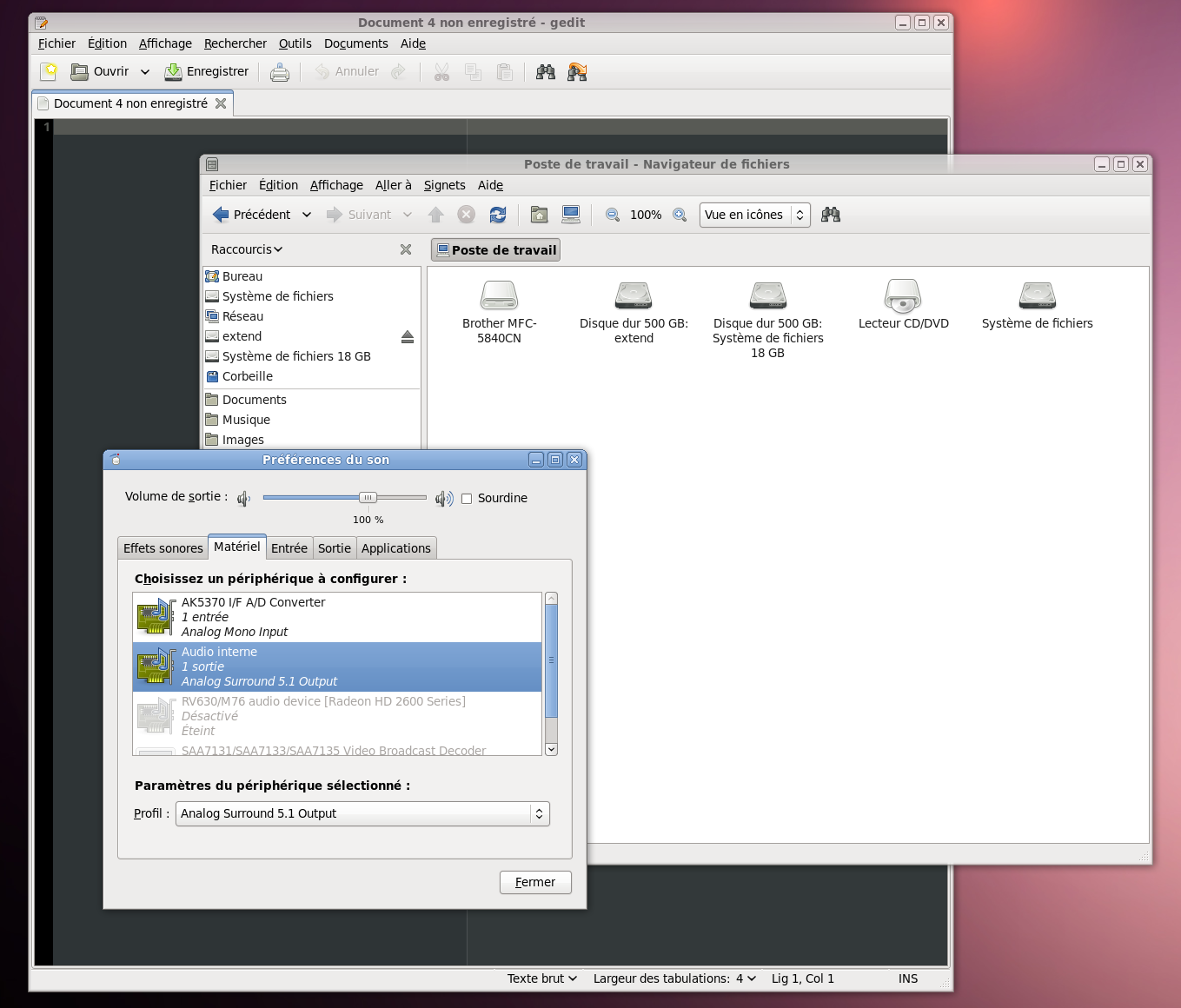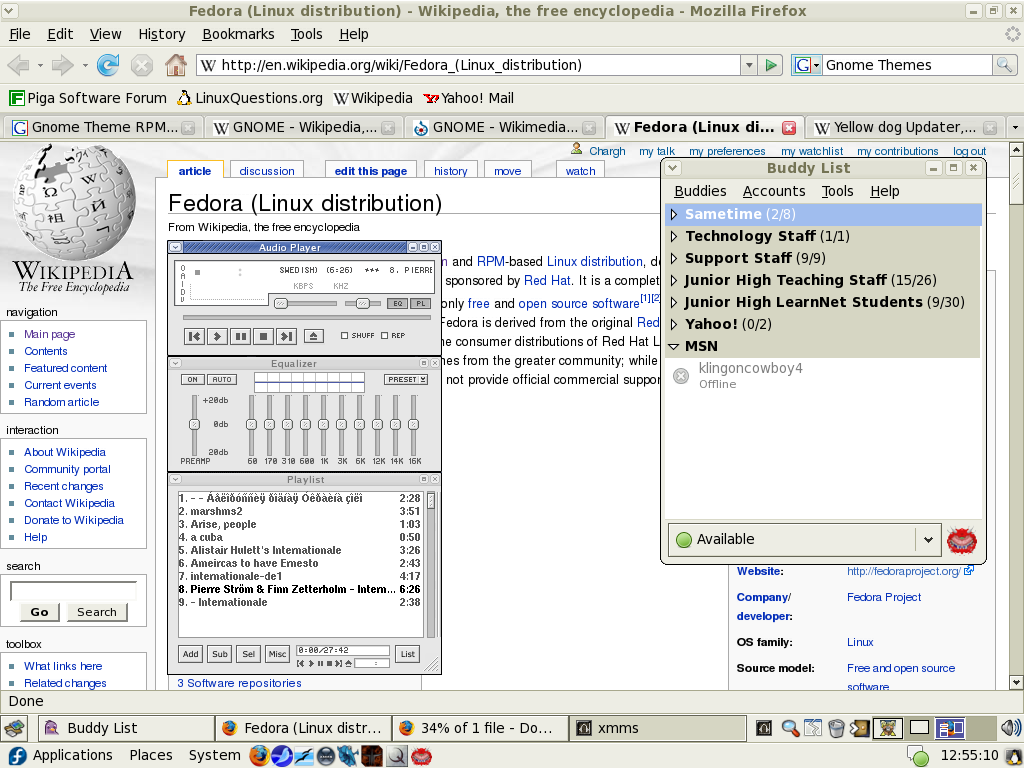|
Clearlooks
Clearlooks is a theme for GTK, the main widget toolkit used by the GNOME desktop environment. It is based on Red Hat's Bluecurve theme. It was the default theme for GNOME since version 2.12 until GNOME 3 when it was replaced by Adwaita. Many users have contributed themes that have changed the colors and some visual effects, leading to many derivative themes. The creators of the Clearlooks GTK+ theme were Richard Stellingwerff and Daniel Borgmann; however, since 2005 the theme has been developed by GNOME, and current developers are Andrea Cimitan and Benjamin Berg. The current version of Clearlooks uses cairo as a backend. Older releases just use GDK to draw the widgets. Qt, versions 4.2 to 4.4, use a port of Clearlooks called ''Cleanlooks'' to better integrate with GTK applications. GTK+ 3 Support Since the departure of the GNOME Project from the development of GNOME 2 and GTK+ 2, developers forked GNOME 2 and created the MATE Mate may refer to: Science * Mate, one ... [...More Info...] [...Related Items...] OR: [Wikipedia] [Google] [Baidu] |
Adwaita (design Language)
Adwaita is the design language of the GNOME desktop environment. As an implementation, it exists as the default theme and icon set of the GNOME Shell and Phosh, and as widgets for applications targeting usage in GNOME. Adwaita first appeared in 2011 with the release of GNOME 3.0 as a replacement for the design principles used in Clearlooks, and with incremental modernization and refinements, continues with current version releases. Until 2021, Adwaita's theme was included as a part of the GTK widget toolkit, but in an effort to further increase independence and divergent release schedules of GTK from that of GNOME, it has since been migrated to libadwaita, which as an overall project, serves to extend GTK's base widgets with those specifically conforming to the GNOME human interface guidelines. Development Prior to version 3.0, the GNOME desktop environment utilized the Clearlooks theme. In October 2008, designers and developers met at the GNOME User Experience Hackfest ... [...More Info...] [...Related Items...] OR: [Wikipedia] [Google] [Baidu] |
Bluecurve
Bluecurve is a Theme (computing), desktop theme for GNOME and KDE created by the Red Hat Artwork project. The main aim of Bluecurve was to create a consistent look throughout the Linux environment, and provide support for various Freedesktop.org desktop standards. It was used in Red Hat Linux in version 8 and 9, and in its successor OS, Fedora Linux through version 4. The Bluecurve window (computing), window borders and GTK theme were replaced by those from Clearlooks (the former in Fedora Core 4, and the latter in Fedora Core 5). The Bluecurve icon (computing), icon set remained installed in Fedora 7, but was replaced as the default bEcho There had been controversy surrounding the theme, especially the alterations to KDE, which were sufficient to cause developer Bernhard Rosenkränzer, Bernhard Rosenkraenzer to quit Red Hat, "mostly in mutual agreement — I don't want to work on crippling KDE, and they don't want an employee who admits RHL 8.0's KDE is crippleware." Others ... [...More Info...] [...Related Items...] OR: [Wikipedia] [Google] [Baidu] |
Widget Toolkit
A widget toolkit, widget library, GUI toolkit, or UX library is a library (computing), library or a collection of libraries containing a set of graphical control elements (called ''widgets'') used to construct the graphical user interface (GUI) of programs. Most widget toolkits additionally include their own Rendering (computer graphics), rendering engine. This engine can be specific to a certain operating system or windowing system or contain back-ends to interface with multiple ones and also with rendering APIs such as OpenGL, OpenVG, or EGL (API), EGL. The look and feel of the graphical control elements can be hard-coded or decoupled, allowing the graphical control elements to be Theme (computing), themed/Skin (computing), skinned. Overview Some toolkits may be used from other languages by employing language bindings. Graphical user interface builders such as e.g. Glade Interface Designer facilitate the authoring of GUIs in a WYSIWYG manner employing a user interface markup la ... [...More Info...] [...Related Items...] OR: [Wikipedia] [Google] [Baidu] |
GNOME
A gnome () is a mythological creature and diminutive spirit in Renaissance magic and alchemy, introduced by Paracelsus in the 16th century and widely adopted by authors, including those of modern fantasy literature. They are typically depicted as small humanoids who live underground. Gnome characteristics are reinterpreted to suit various storytellers and artists. Paracelsus's gnome is recognized to have derived from the German miners' legend about or , the "metallurgical or mineralogical demon", according to Georg Agricola (1530), also called (literal Latinization of ''Bergmännlein'', "mountain manikin") by Agriocola in a later work (1549), and described by other names such as (sing. ; Latinization of German ). Agricola recorded that, according to the legends of that profession, these mining spirits acted as miming and laughing pranksters who sometimes threw pebbles at miners, but could also reward them by depositing a rich vein of silver ore. Paracelsus also called ... [...More Info...] [...Related Items...] OR: [Wikipedia] [Google] [Baidu] |
Red Hat
Red Hat, Inc. (formerly Red Hat Software, Inc.) is an American software company that provides open source software products to enterprises and is a subsidiary of IBM. Founded in 1993, Red Hat has its corporate headquarters in Raleigh, North Carolina, with other offices worldwide. Red Hat has become associated to a large extent with its enterprise operating system Red Hat Enterprise Linux. With the acquisition of open-source enterprise middleware vendor JBoss, Red Hat also offers Red Hat Virtualization (RHV), an enterprise virtualization product. Red Hat provides storage, operating system platforms, middleware, applications, management products, support, training, and consulting services. Red Hat creates, maintains, and contributes to many free software projects. It has acquired the codebases of several proprietary software products through corporate mergers and acquisitions, and has released such software under open source licenses. , Red Hat is the second largest co ... [...More Info...] [...Related Items...] OR: [Wikipedia] [Google] [Baidu] |
Cairo (graphics)
Cairo (stylized as cairo) is an Open-source software, open-source graphics library that provides a vector graphics-based, device-independent Application programming interface, API for software developers. It provides primitives for Plane (mathematics), two-dimensional drawing across a number of different front and back ends, backends. Cairo uses hardware acceleration when available. Software architecture Language bindings A library written in one programming language may be used in another language if language binding, bindings are written; Cairo has a range of bindings for various languages including C++, C Sharp (programming language), C# and other Common Language Infrastructure, CLI languages, Delphi (programming language), Delphi, Eiffel (programming language), Eiffel, Fortran, Factor (programming language), Factor, Harbour (programming language), Harbour, Haskell (programming language), Haskell, Julia (programming language), Julia, Lua (programming language), Lua, Perl, ... [...More Info...] [...Related Items...] OR: [Wikipedia] [Google] [Baidu] |
Qt (software)
Qt ( pronounced "cute") is a cross-platform application development framework for creating graphical user interfaces as well as Cross-platform software, cross-platform applications that run on various software and hardware platforms such as Linux, Windows, macOS, Android (operating system), Android or embedded systems with little or no change in the underlying codebase while still being a native application with native capabilities and speed. Qt is currently being developed by The Qt Company, a publicly listed company, and the Qt Project under open-source governance, involving individual developers and organizations working to advance Qt. Qt is available under both commercial licenses and open-source GNU General Public License, GPL 2.0, GPL 3.0, and GNU Lesser General Public License, LGPL 3.0 licenses. Purposes and abilities Qt is used for developing graphical user interfaces (GUIs) and multi-platform application software, applications that run on all major Desktop computer ... [...More Info...] [...Related Items...] OR: [Wikipedia] [Google] [Baidu] |
LibreOffice On Debian GNU Linux
LibreOffice () is a free and open-source office productivity software suite developed by The Document Foundation (TDF). It was created in 2010 as a fork of OpenOffice.org, itself a successor to StarOffice. The suite includes applications for word processing (Writer), spreadsheets ( Calc), presentations (Impress), vector graphics (Draw), databases ( Base), and formula editing (Math). It supports the OpenDocument format and is compatible with other major formats, including those used by Microsoft Office. LibreOffice is available for Windows, macOS, and is the default office suite in many Linux distributions, and there are community builds for other platforms. Ecosystem partner Collabora uses LibreOffice as upstream code to provide an online solution branded as Collabora Online, and apps for Android, iOS, iPadOS, and ChromeOS operating systems which are branded as Collabora Office. TDF describes LibreOffice as intended for individual users, and encourages enterprises to obtain ... [...More Info...] [...Related Items...] OR: [Wikipedia] [Google] [Baidu] |
MATE (software)
MATE ( ) is a desktop environment composed of free and open-source software that runs on Linux, and other Unix-like operating systems such as BSD, and illumos. Name MATE is named after the South American plant yerba mate and tea made from the herb, mate. The name is stylized in all capital letters to follow the nomenclature of other Free Software desktop environments like KDE Plasma and LXDE. The recursive backronym "MATE Advanced Traditional Environment" was subsequently adopted by most of the MATE community, again in the spirit of Free Software like GNU ("GNU's Not Unix!"). The use of a new name, instead of GNOME, avoids naming conflicts with GNOME 3 components. History Perberos, an Argentine user of Arch Linux, started the MATE project to fork and continue GNOME 2 in response to the negative reception of GNOME 3, which had replaced its traditional taskbar ( GNOME Panel) with GNOME Shell. MATE aims to maintain and continue the latest GNOME 2 code base, frameworks ... [...More Info...] [...Related Items...] OR: [Wikipedia] [Google] [Baidu] |




